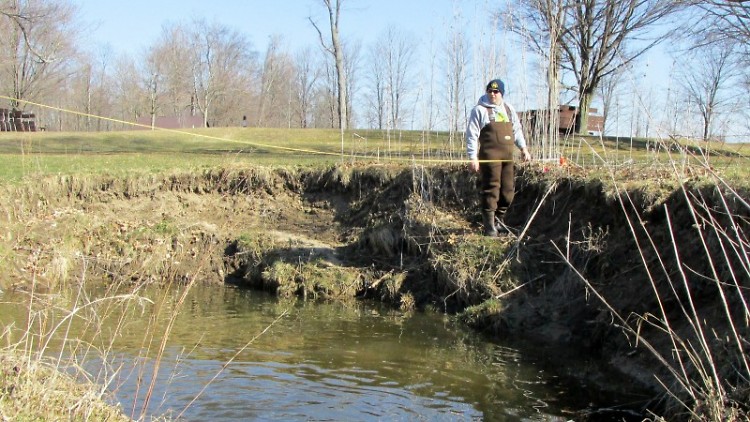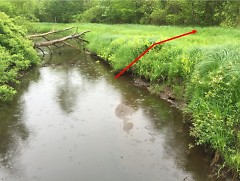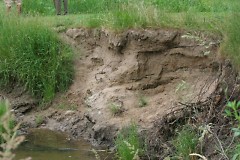"We came to Michigan when I was 10 years old, and a little way from my home was Plaster Creek…That stream was my playground during the next six or eight years…my companions [and I knew] the individuality of a great many trees; we knew the kinds of fish that made their home in that creek. We even had a boat and paddled up the stream for miles and enjoyed each summer the beauties of that most delightful natural playground. [The stream] that gave me this joy...is now a most fitful affair… The playground is gone. Where there was one child then to enjoy that playground there are now 8,000 children who ought to have a playground like this, but a near sighted utilitarianism has snatched it away. We have stolen their rightful heritage from them…we are forgetful of the children’s playgrounds and the children’s rights of play."
-Charles Garfield, 1910. In an address to the State Horticultural Society of Michigan.
Only 18 acres in size, Shadyside is one of Kent County’s smallest parks. With an open shelter, several picnic areas, and a mixed landscape of open fields, mature shade canopies, and beautiful natural scenery, this small park still sees a lot of activity. Be it a spring picnic, a family reunion, a game of ultimate Frisbee or a field trip for local students, it’s clear that the park is an important community asset. A defining feature of Shadyside Park is Plaster Creek, a small stream which meanders east to west through the property. You’d be hard-pressed to resist the attractive lure of walking along the moving water, and in the fall, you might even spot a spawning salmon or two.
But the pleasant country scenery can be deceptive. This seemingly peaceful section of stream, often just a slow babble in mid-summer, surges high in the aftermath of a rain event, turning the water brown with sediment as it flows rapidly through park. Even during low-flows, if you know what to look for, it’s obvious that the stream experiences volatile and forceful discharges. Many of the banks are rapidly eroding. In some sections, grassy mounds stick out of the channel where the banks have slumped into the stream. In the lawn above the banks, thick bands of sand lie in the grass where a pulse of water from the last big storm deposited them. In the worst areas, the banks are receding at rates of about one foot per year. With close to half a mile of linear streambank in the park (two sides of the stream run for a quarter mile), the annual amount of sediment that erodes from this small park is likely greater than what a 30 ton dump truck could haul.
This high volume of sediment makes for dirty water that is inhospitable to all but the most pollution tolerant creatures, and stream sampling for aquatic organisms at Shadyside Park and in other areas of Plaster Creek has confirmed extremely low levels of aquatic biodiversity. While Shadyside Park is hardly the worst site of erosion along the banks of Plaster Creek, its upstream location within the watershed make it an important factor in influencing downstream water quality. Over time, the sediment that muddies the water here, unless otherwise removed or deterred, continues to flow for the 20+ miles of stream that meander north toward the Grand River.
In our efforts to engage and educate watershed residents about our vision for a restored, healthy Plaster Creek, we hear from people about their relationship to the stream and how that relationship has changed over time. Long-time residents near Shadyside Park often describe how they used to play and swim in the stream as children, and some even tell us about all the fish they used to see in the stream. Some locals recall a small tributary that they could hop across, but after decades of flashy flows and channel erosion, the creek now flows too wide and deep to jump over. Some people don’t make the connection that the stream at Shadyside Park is actually Plaster Creek, while others seem quite aware of the interconnected nature of the stream that flows through their community, and its relation to the health of everything downstream.
The problems of Plaster Creek are complicated, and the solutions are equally complex. But it is our hope that a large-scale restoration project at Shadyside Park, currently slated for construction in summer 2016, will improve the beauty of the park and will function as a big step forward in the long-term work of restoring the watershed. Still in the final phases of planning, the restoration project will involve re-contouring areas along the stream to create a stable floodplain “bench.” Functionally, this means that those steep, eroding, cliff-like banks will be transformed into broader, gentler slopes that will resist erosion and be safer for children—or anyone else for that matter—who heed the beckoning call of a babbling stream and venture along its edge. The transformation will include revegetating the streambanks with deeply rooted native grasses, sedges, and wildflowers that are a foundational component of functional floodplains.
Healthy floodplains are a necessary feature of healthy streams. By creating a stable flood bench between the tops of the high banks and the bottom of the channel (which is currently non-existent), we restore vital habitat that in addition to serving as a flood buffer and pollutant filter will also provide valuable habitat for a diversity of organisms.
Plaster Creek’s degradation has been decades (if not centuries!) in the making. One large project at Shadyside Park won’t make the stream safe to swim in any time soon. However, it will have immediate impacts locally, restoring a significant section of stream at a park that has been a community asset for nearly 80 years. Additionally, as understanding grows that we are intimately connected to our downstream neighbors, we hope this upstream project is the first of many future efforts that will have impacts throughout the watershed. It may be a lofty goal—a healthy, biologically rich, flourishing, fishable and swimmable playground; but it is our rightful heritage, a watershed restored.
The Rapidian, a program of the 501(c)3 nonprofit Community Media Center, relies on the community’s support to help cover the cost of training reporters and publishing content.
We need your help.
If each of our readers and content creators who values this community platform help support its creation and maintenance, The Rapidian can continue to educate and facilitate a conversation around issues for years to come.
Please support The Rapidian and make a contribution today.



